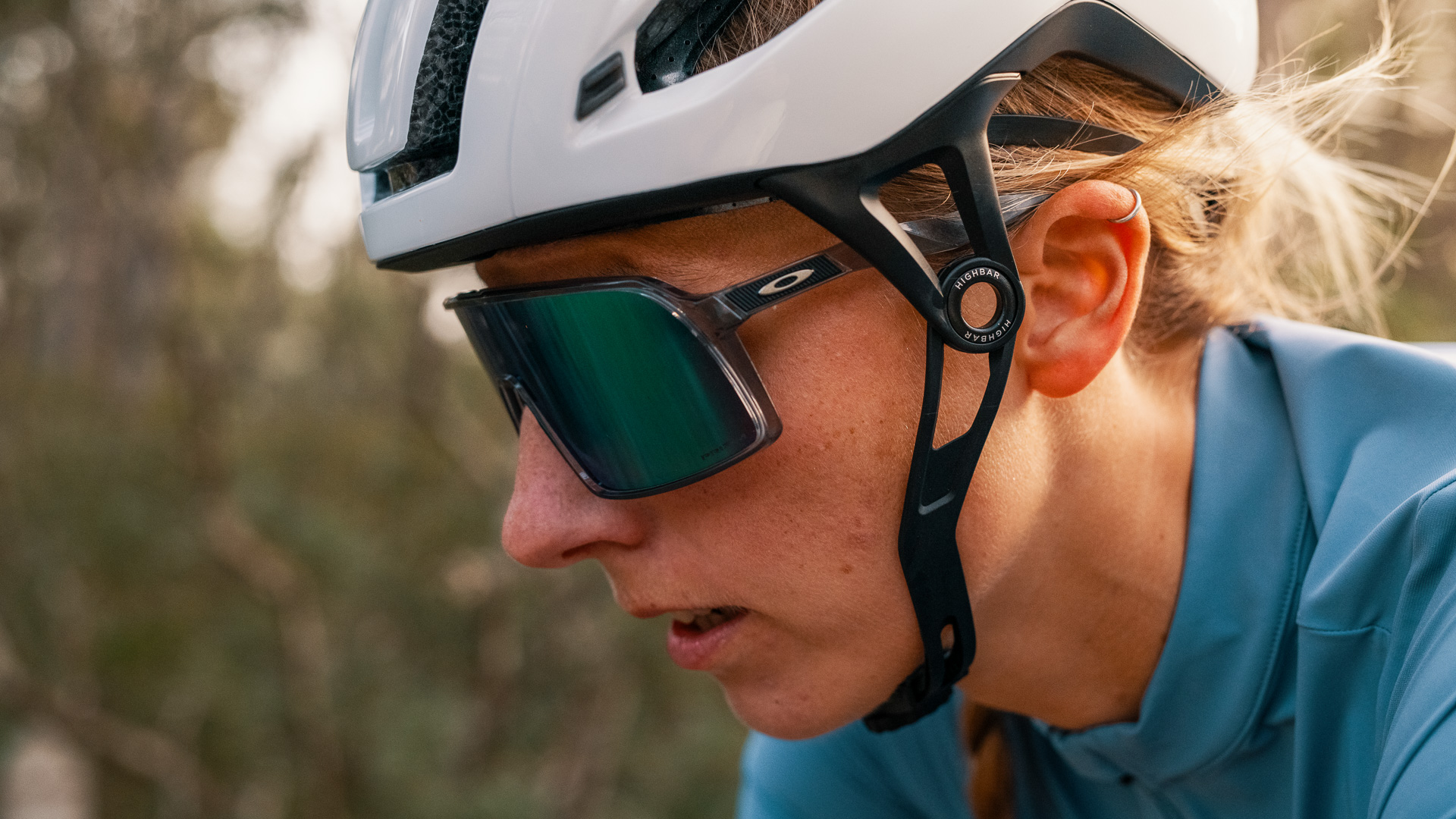Remember that wild new Canyon helmet we saw back in February? Well, it turns out that the “wild” part of that helmet, i.e. the single strap, was not Canyon at all but a new take on helmet straps from HighBar Systems specifically designed to improve safety and helmet performance.
If you missed it back then, the HighBar Systems strap design ditches half the conventional Y-shaped yoke traversing either side of the ear in favour of a mono-strap design running down the side of the face. The mono-strap, as we described it back in February, features a rotary dial retention system in place of a regular buckle, a hard plastic strap replaces the nylon or leather straps typically found in existing designs, and most notably, the new concept features a pivoting anchor just in front of the ear that splits off into two separate anchoring points on the rim of the helmet.
All told, the visual elements of HighBar’s new strap concept are drastically different to the straps commonly used in practically every cycling helmet currently on offer. But those visual elements are only part of the new concept with HighBar also taking a new approach to how the straps anchor to the helmet.
Furthermore, while we initially speculated this was a Canyon design, we now know that Canyon will merely make the first helmets available with this new technology. Think of HighBar a little like MIPS: a safety-focused addition to an existing helmet, which will be available to manufacturers under license from HighBar.
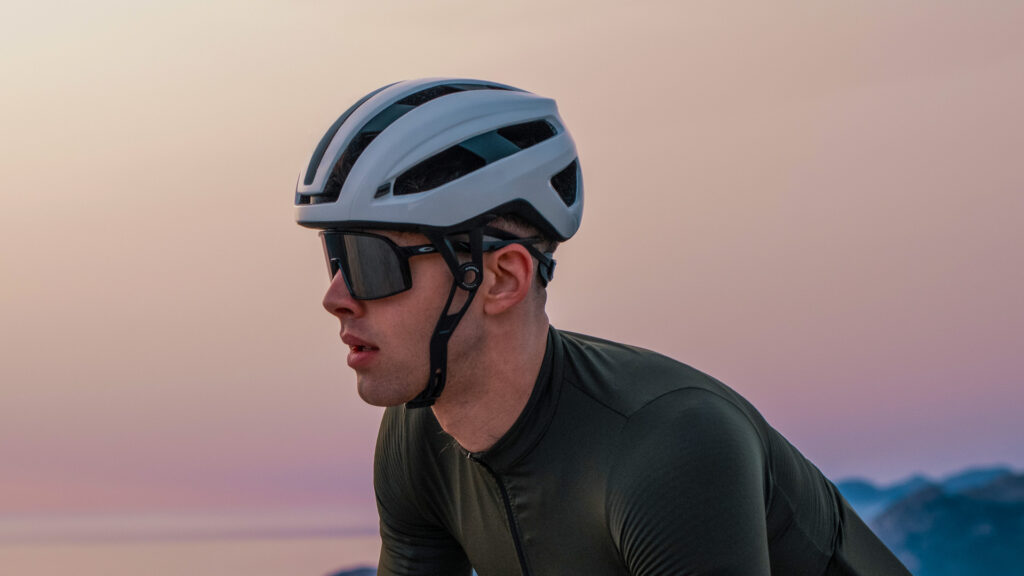
But why?
Helmets and helmet straps aren’t exactly broken; in fact, helmets are more advanced, comfortable, and aero than ever, but HighBar still believes they need fixing. Why so? According to HighBar, “traumatic brain injuries are still common”, and this can be traced back not to the helmet shell itself but to the lack of “innovation below the ears in over 100 years.”
A HighBar representative told Escape Collective many helmets fail testing not because they can’t absorb impacts but because they simply come off the head in testing. The brand points to a study conducted in 1995, which claims a 300% increase in the risk of head injury if a helmet ejects during a crash, a 52% increase in injury from a poorly fitted helmet (tipped back vs centred), and that an ill-fitting helmet is only 50% as effective as a properly fitting helmet.
Another study of 479 children showed that only 20 had properly fitted helmets in good condition, a finding I can definitely relate to, given my past experience delivering cycling programs in primary schools. The main issues identified in this study were incorrect positioning on the forehead (the helmet sat too high and too far back), improper strap position, and excessive fore/aft movement. Anecdotally, from my own experience, I’d add wearing helmets back to front to that list.
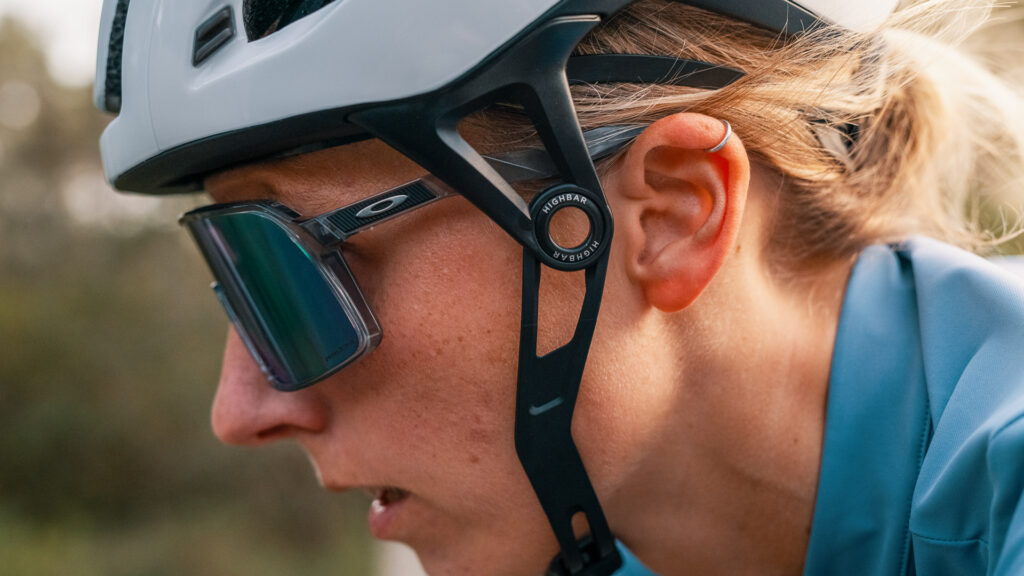
It was with all this in mind that HighBar set out to create a strap that was easy to adjust, fit correctly, and crucially aimed to eliminate user error on “every helmet and every rider on every ride, with the twist of a dial.” The brand also wants all helmets to continue being comfortable, lightweight, aerodynamic, and stylish. That’s a lofty set of ambitions that one may be tempted to respond to with a pun including the brand name, but that’s where the HighBar strap concept comes in.
Again, HighBar has only rethought helmet retentions systems; it is now hoping various manufacturers will adopt this new strap concept like Canyon has.
How?
Before delving into how the new strap concept works, let’s first take a second to explain who HighBar actually is. Co-founded and invented by Carl Winefordner and Frank Hermansen (the design brains behind the Crankbrothers Eggbeater pedal, Spandex adjustable coil spring, Hydrapak hydration reservoirs, and the Fit5 multi-cleat compatible fitness bike pedal) the company also lists what effectively amounts to a who’s who of industry veterans and respected designers too lengthy to mention here. They were all brought together to take Winefordner and Hermansen’s new approach to strap design and make it a reality.
What that hive-mind came up with is the mono-strap, pivoting anchor design we see today. Functionally in terms of daily use, the strap rotates around the pivot point near the helmet rim. Rotated upwards the shell effectively opens the helmet for a rider to put it on or take it off. Once on, the rider swings the strap down in front of their face to the standard under-the-chin buckle position. Once in place, a twist of the rotary dial tightens the helmet strap just like a BOA dial on a cycling shoe.
As for how exactly the group aims to eliminate user error with the new strap concept, it is pretty clear to see once you know what to look for. Chiefly, the elimination of the Y-strap means the elimination of the potential for someone to get it wrong by not fitting it correctly around the ears. Furthermore, the hard plastic construction should prevent users from wearing the helmet back to front or otherwise incorrectly as it can not be bent or rerouted to match an incorrectly positioned helmet.
Again, think about those you’ve seen wearing a helmet back to front – this is only possible as the flexible straps can be adjusted and moved to still allow the user to buckle the strap beneath the chin. With the HighBar system, this isn’t possible.
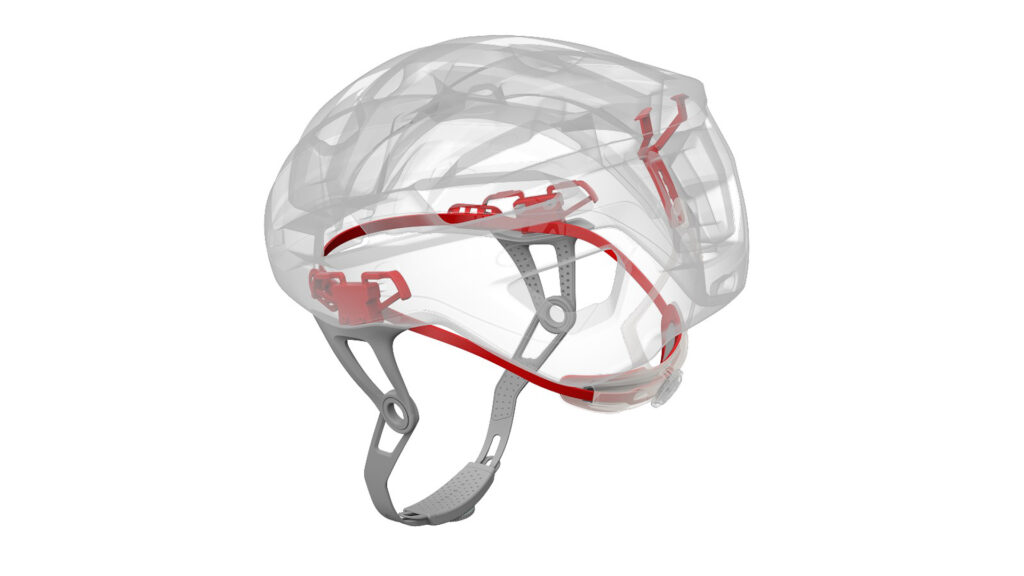
The hard plastic strap construction and rotary dial retention system effectively double up as a sort of self-centring mechanism, effectively preventing poorly fitted helmets. In short, due to the combination of the new strap and rear retention system, it’s very difficult to wear the helmet incorrectly. This almost-forced fit should tackle the 52% increase in injuries from a poorly fitted helmet (tipped back vs centred), and the 50% reduction in helmet effectiveness from poor fit.
But the claimed benefits run deeper than the eye can see. As mentioned earlier, correctly fitted helmets fail safety testing because they eject from the head on impact during a controlled test. According to the HighBar representative we spoke to, this can happen either because the Y-shaped yoke isn’t fitted properly or because the straps separate entirely from the protective shell on impact. Naturally, a helmet cannot protect a rider from subsequent impacts if it is no longer on their head.
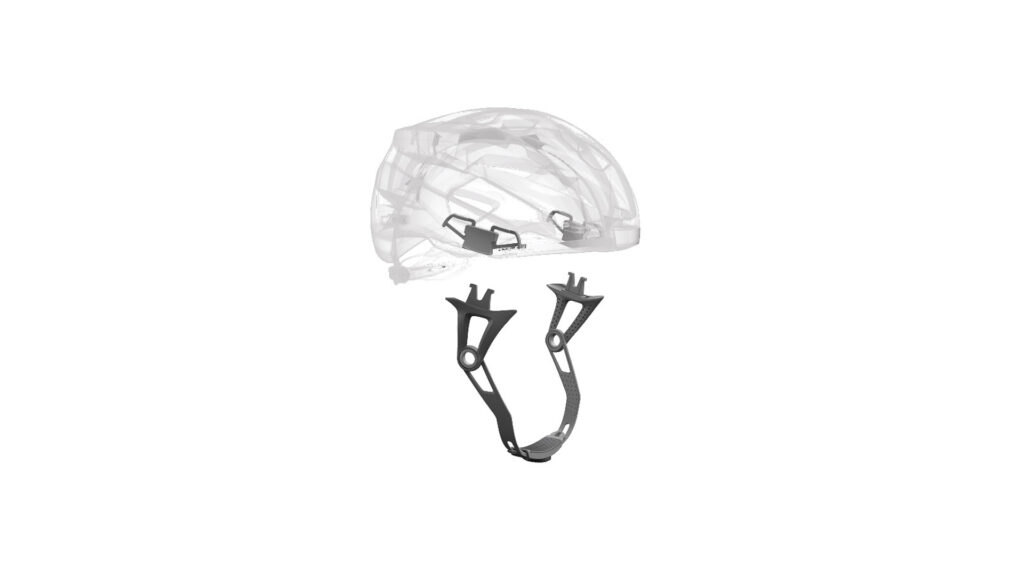
HighBar anchors its new strap deep into the helmet with a two-pronged hook-like anchor embedded in the helmet shell specifically to reduce the chances of the shell separating from the strap. And while all of our focus so far has been on the mono-strap, HighBar’s new concept also combines the circumferential retention system at the rear of the helmet into the strap design as a package system rather than a separate system (the normal way of things). This combined approach is said to further improve helmet retention upon impact. It does also mean the HighBar system cannot be retrofitted to existing helmets.
All told, the new strap concept is said to “increase the probability” a rider wears their helmet correctly. It is also claimed to give the helmet a better chance of doing its job in the event of an impact. Crucially, the HighBar Retention System has been tested and certified to CPSC and EN1078 standards, with the brand claiming the product exceeds these standards. We have asked for confirmation the design has passed the Australian AS/NZS 2063:2008 standard. Ultimately, though, it is each helmet that must pass these safety standards. If the HighBar system delivers on its promise, it should merely be an aid in passing said tests.
This all sounds like a win-win, right? Well, not entirely.
I got a chance to try a helmet with the HighBar strap on a recent trip to Belgium. That said, I tried it at a meeting with a representative at a table and not on a bike. Needless to say, I also didn’t and couldn’t test the claimed benefits even if I had ride-tested the new concept.
With that in mind, and going back to HighBar’s goals for helmets – lightweight, stylish, comfortable, aerodynamic, and easy to adjust and wear correctly – I did find the new strap concept definitely hits the “easy to adjust and wear correctly” targets. There is still a chance a rider might not swing the retention strap down to below the chin but it is intuitive for most that a helmet strap tightens under the chin rather than on the forehead. Nevertheless, it is something I highlighted with HighBar for consideration.
Secondly, and entirely subjectively, the new strap design and the requirement to run the arms of glasses beneath the strap will not be to everyone’s aesthetic tastes. Presumably, HighBar is aware beauty is in the eye of the beholder, and as such, the “stylish” goal is merely a stretch goal of sorts. That said, the new look may prove the biggest hurdle for widespread adoption.
Then there’s comfort and the somewhat accidental aero 7-watt saving HighBar claims to have found in comparing the same helmet with webbing straps vs the new HighBar strap in testing at the San Diego Low Speed Wind Tunnel. Seven watts seems like a huge saving from the humble strap, and so we have requested more information on the testing. Needless to say, the position and fit of each strap style could be critical in any aero testing. Regardless of the result, if helmet straps are anything like helmets in general, the aero benefits could prove highly individual and probably should be a distant secondary priority to outright safety.
While safety and aerodynamics are important motivating factors in our choice of helmets, for many more leisurely or casual cyclists – and kids – actually choosing to wear a helmet (provided they have one) often comes down to comfort. Unfortunately, too often, kids don’t have helmets because parents can’t afford them, but for those that do, the “not-cool” and “not comfortable” factors will dictate whether they actually wear their helmet. I can’t speak to whether kids will deem the HighBar system cooler than a traditional strap and buckle – perhaps they will – but I can say the new strap concept certainly feels different and I’ll have to reserve judgement on the strap comfort.
Playing about with the new strap for 20 minutes or so, trying it on, taking it off, sitting at a pub table late at night wearing a bicycle helmet, I can say the new strap does take a bit of getting used to. It is definitely easy to use, but the hard and solid strap is quite the contrast to the soft flexible fit of more traditional webbed straps. For the most part I didn’t actually notice the strap against my face but I did feel a slight pressure on my laryngeal prominence (Adam’s apple), which, although slight was definitely enough to provide a disconcerting sensation. I’d questioned if the bottom section of that plastic strap could be made with a more traditional strap and buckle style, but on reflection; it seems this solid construction with a rotary retention system is key to the entire correct fit philosophy.
That said, it’s possible this slight pressure I felt may be eliminated in the more rotated neck position we typically adopt while riding vs sitting at a table. Furthermore, the HighBar system totally eliminates all the faffing about etc. we must do to fit the Y-shaped yokes to our ears and keep the traditional strap fitting close to the face. The new concept is as simple as dropping the strap down and twisting a dial.
Continuing on the comfort theme, HighBar is also claiming a cooling and noise-reduction benefit from the new strap concept, to the tune of an “8º thermal advantage” and a noise reduction benefit of “6-7.5 decibels” again vs “the same helmet with webbing straps”. Again I couldn’t assess either of these claims in the short time I had with the helmet.
Crucially, also, the system didn’t seem to impact how the helmet fit the rest of my head at all and while I expected the anchor points to be at least somewhat visible in my peripheral vision, they were entirely out of sight and didn’t provide any blind spots or obscure my vision in any way. The fit and feel of the protective shell is akin to how I believe the same helmet would feel if it was fitted with a traditional strap.
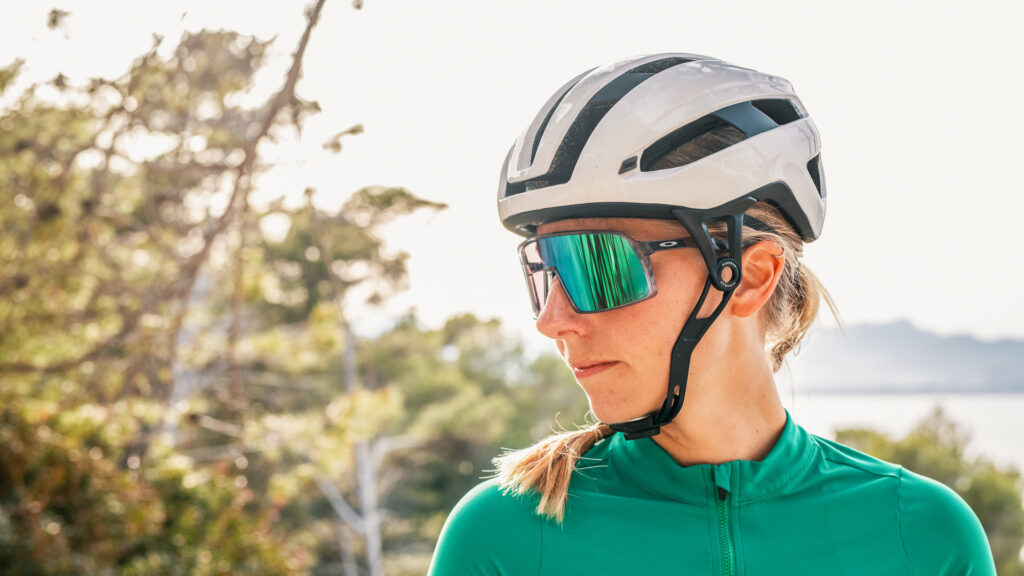
One larger hurdle that may prove more problematic is eating on the bike. Again, it was difficult to get a proper feel for this without actually trying it on the bike, but the solid construction and retention system did seem to limit jaw movement enough that I’d likely want to open and tighten the rotary dial if I were to eat something on the bike. That seems like it could be a pain for the performance-focused and/or longer-distance rider.
By longer distances I mean anyone who enjoys riding for an hour or more vs the leisurely cyclist in parks or kids cycling about for fun. Arguably, it’s these less experienced cyclists who need helmets designed to eliminate user error the most. Understanding now some of the potential failure points a helmet experiences, I’ll be tracking with interest how widely adopted the HighBar system is.
I also look forward to a proper field test of the system. Ultimately, I probably already have to admit that how comfortable the strap is on the bike and the simple requirement to be able to eat without loosening the helmet strap may well determine how practical and widely adopted this new design is, not just for me but many readers of this article. How widely adopted it is with the wider population will undoubtedly come down to price. With lower prices will come wider adoption and I’d hazard a guess that wider adoption begets wider adoption.
Again, as the HighBar strap is effectively an option for inclusion on other manufacturers’ helmets, HighBar can’t provide pricing details for a HighBar-equipped helmet, but it did say it doesn’t envisage the system adding huge costs to a helmet. Only time, and presumably a host of upcoming helmet launches, will truly give an insight into firstly how widely adopted the HighBar system will be and secondly what premium, if any, will apply compared to a more traditional strap.
What did you think of this story?
